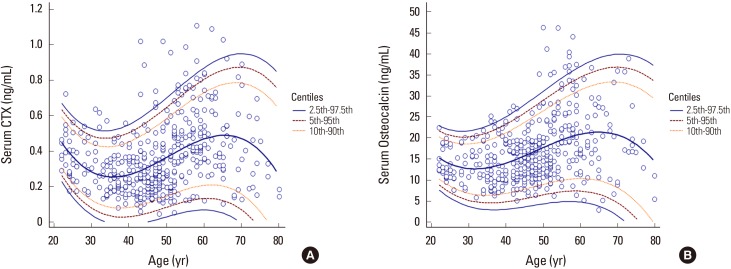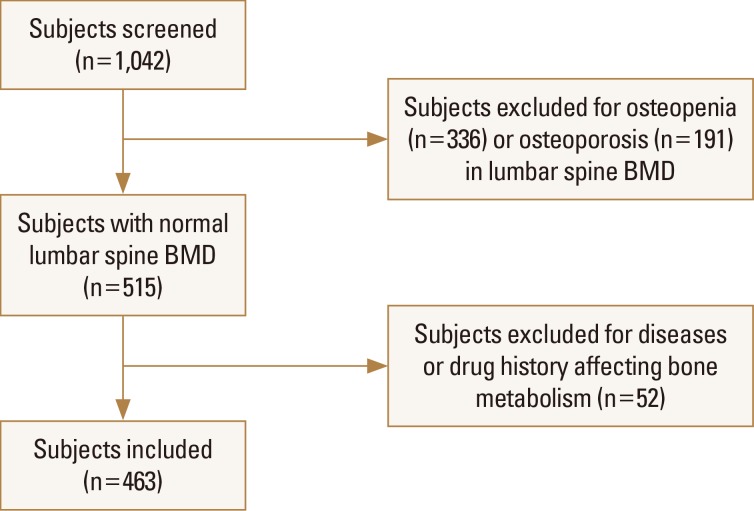1. Garnero P, Shih WJ, Gineyts E, et al. Comparison of new biochemical markers of bone turnover in late postmenopausal osteoporotic women in response to alendronate treatment. J Clin Endocrinol Metab 1994;79:1693-1700.

2. Delmas PD, Hardy P, Garnero P, et al. Monitoring individual response to hormone replacement therapy with bone markers. Bone 2000;26:553-560.


5. de Papp AE, Bone HG, Caulfield MP, et al. A cross-sectional study of bone turnover markers in healthy premenopausal women. Bone 2007;40:1222-1230.


6. Gertz BJ, Shao P, Hanson DA, et al. Monitoring bone resorption in early postmenopausal women by an immunoassay for cross-linked collagen peptides in urine. J Bone Miner Res 1994;9:135-142.


7. Vasikaran S, Eastell R, Bruyère O, et al. Markers of bone turnover for the prediction of fracture risk and monitoring of osteoporosis treatment: a need for international reference standards. Osteoporos Int 2011;22:391-420.


8. Srivastava AK, Vliet EL, Lewiecki EM, et al. Clinical use of serum and urine bone markers in the management of osteoporosis. Curr Med Res Opin 2005;21:1015-1026.


9. Johansson H, Odén A, Kanis JA, et al. A meta-analysis of reference markers of bone turnover for prediction of fracture. Calcif Tissue Int 2014;94:560-567.

10. Glendenning P. Markers of bone turnover for the prediction of fracture risk and monitoring of osteoporosis treatment: a need for international reference standards: osteoporos int 2011;22:391-420. Clin Biochem Rev 2011;32:45-47.


11. Garnero P, Sornay-Rendu E, Claustrat B, et al. Biochemical markers of bone turnover, endogenous hormones and the risk of fractures in postmenopausal women: the OFELY study. J Bone Miner Res 2000;15:1526-1536.


12. Yoon BH, Yu W. Clinical utility of biochemical marker of bone turnover: Fracture risk prediction and bone healing. J Bone Metab 2018;25:73-78.

13. Recker R, Lappe J, Davies KM, et al. Bone remodeling increases substantially in the years after menopause and remains increased in older osteoporosis patients. J Bone Miner Res 2004;19:1628-1633.


14. Recker R, Stakkestad JA, Chesnut CH 3rd, et al. Insufficiently dosed intravenous ibandronate injections are associated with suboptimal antifracture efficacy in postmenopausal osteoporosis. Bone 2004;34:890-899.


15. Pi YZ, Wu XP, Liu SP, et al. Age-related changes in bone biochemical markers and their relationship with bone mineral density in normal Chinese women. J Bone Miner Metab 2006;24:380-385.


16. Hoshino H, Kushida K, Takahashi M, et al. Changes in levels of biochemical markers and ultrasound indices of Os calcis across the menopausal transition. Osteoporos Int 2000;11:128-133.


17. Glover SJ, Gall M, Schoenborn-Kellenberger O, et al. Establishing a reference interval for bone turnover markers in 637 healthy, young, premenopausal women from the United Kingdom, France, Belgium, and the United States. J Bone Miner Res 2009;24:389-397.


18. Glover SJ, Garnero P, Naylor K, et al. Establishing a reference range for bone turnover markers in young, healthy women. Bone 2008;42:623-630.


19. Adami S, Bianchi G, Brandi ML, et al. Determinants of bone turnover markers in healthy premenopausal women. Calcif Tissue Int 2008;82:341-347.


21. Wu XY, Zhang H, Xie H, et al. Reference intervals of bone turnover markers determined by using their curve-fitting valley for adult females in China. Osteoporos Int 2014;25:943-952.


22. Ardawi MS, Maimani AA, Bahksh TA, et al. Reference intervals of biochemical bone turnover markers for Saudi Arabian women: a cross-sectional study. Bone 2010;47:804-814.


24. Bae SJ, Kim BJ, Lim KH, et al. Efficacy of intravenously administered ibandronate in postmenopausal Korean women with insufficient response to orally administered bisphosphonates. J Bone Miner Metab 2012;30:588-595.


25. Eastell R, Barton I, Hannon RA, et al. Relationship of early changes in bone resorption to the reduction in fracture risk with risedronate. J Bone Miner Res 2003;18:1051-1056.


26. Eastell R, Garnero P, Audebert C, et al. Reference intervals of bone turnover markers in healthy premenopausal women: results from a cross-sectional European study. Bone 2012;50:1141-1147.


27. Jenkins N, Black M, Paul E, et al. Age-related reference intervals for bone turnover markers from an Australian reference population. Bone 2013;55:271-276.


28. Michelsen J, Wallaschofski H, Friedrich N, et al. Reference intervals for serum concentrations of three bone turnover markers for men and women. Bone 2013;57:399-404.


31. Iki M, Akiba T, Matsumoto T, et al. Reference database of biochemical markers of bone turnover for the Japanese female population. Japanese Population-based Osteoporosis (JPOS) Study. Osteoporos Int 2004;15:981-991.


32. Kanis JA, Odén A, McCloskey EV, et al. A systematic review of hip fracture incidence and probability of fracture worldwide. Osteoporos Int 2012;23:2239-2256.

33. Kleerekoper M, Nelson DA, Peterson EL, et al. Reference data for bone mass, calciotropic hormones, and biochemical markers of bone remodeling in older (55-75) postmenopausal white and black women. J Bone Miner Res 1994;9:1267-1276.


34. Finkelstein JS, Sowers M, Greendale GA, et al. Ethnic variation in bone turnover in pre- and early perimenopausal women: effects of anthropometric and lifestyle factors. J Clin Endocrinol Metab 2002;87:3051-3056.


35. Aloia JF, Mikhail M, Pagan CD, et al. Biochemical and hormonal variables in black and white women matched for age and weight. J Lab Clin Med 1998;132:383-389.


37. Cosman F, Morgan DC, Nieves JW, et al. Resistance to bone resorbing effects of PTH in black women. J Bone Miner Res 1997;12:958-966.


38. Fuleihan GE, Gundberg CM, Gleason R, et al. Racial differences in parathyroid hormone dynamics. J Clin Endocrinol Metab 1994;79:1642-1647.

39. Garnero P, Sornay-Rendu E, Chapuy MC, et al. Increased bone turnover in late postmenopausal women is a major determinant of osteoporosis. J Bone Miner Res 1996;11:337-349.


40. Bauer DC, Sklarin PM, Stone KL, et al. Biochemical markers of bone turnover and prediction of hip bone loss in older women: the study of osteoporotic fractures. J Bone Miner Res 1999;14:1404-1410.


42. Guañabens N, Filella X, Monegal A, et al. Reference intervals for bone turnover markers in Spanish premenopausal women. Clin Chem Lab Med 2016;54:293-303.

43. Suk JH, Cho EH, Lee SY, et al. Laboratory evaluation of bone metabolism index using elecsys 2010. Korean J Lab Med 2006;26:146-152.


44. Teegarden D, Proulx WR, Martin BR, et al. Peak bone mass in young women. J Bone Miner Res 1995;10:711-715.


45. Wu XP, Liao EY, Huang G, et al. A comparison study of the reference curves of bone mineral density at different skeletal sites in native Chinese, Japanese, and American Caucasian women. Calcif Tissue Int 2003;73:122-132.

















 PDF Links
PDF Links PubReader
PubReader ePub Link
ePub Link Full text via DOI
Full text via DOI Full text via PMC
Full text via PMC Download Citation
Download Citation Print
Print



